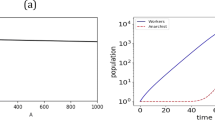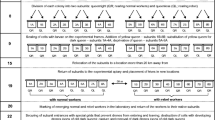Summary
In 11 Apis mellifera colonies with laying queens, about 0.12% of the males produced derived from eggs laid by workers. This result requires explanation both of why workers produce any males, and, since they do, why they produce so few. Workers may maximize their inclusive fitness by forgoing reproduction, or their sterility may be due to to enforcement of the interests of the queen or those of other workers. The presence of laying workers might then result from developmental noise in the workers, from a failure of communication of the queen's presence, or a failure of enforcement mechanisms. Selection for worker reproduction in colonies following queen loss may also play a role in shaping worker reproduction in colonies with a queen. The hypothesis of worker sterility enforced by other workers seems most likely to be correct, but further studies on these hypotheses are needed.
Similar content being viewed by others
References
Bourke AFG (1988) Worker reproduction in the higher eusocial hymenoptera. Q Rev Biol 63:291–311
Buss LW (1987) The evolution of individuality. Princeton Univ Press, Princeton
Evers C, Seeley TD (1986) Kin discrimination and aggression in honey bee colonies with laying workers. Anim Behav 34:924–925
Free JB (1987) Pheromones of social bees. Cornell University Press, Ithaca, NY
Howell DE, Usinger RL (1933) Observations on the flight and length of life of drone bees. Ann Ent Soc Amer 26:239–246
Jay SC (1968) Factors influencing ovary development of worker honeybees under natural conditions. Canad J Zool 46: 345–347
Jay SC (1970) The effect of various combinations of immature queen and worker bees on the ovary development of worker honeybees in colonies with and without queens. Canad J Zool 48:169–173
Kropácová S and Haslbachová H (1969) The development of ovaries in worker honeybees in a queenright colony. J Apic Res 8:57–64
Kropácová S, Haslbachová H (1970) The development of ovaries in worker honeybees in queenright colonies examined before and after swarming. J Apic Res 9:65–70
Kropácová S, Haslbachová H (1971) The influence of queenlessness and of unsealed brood on the development of ovaries in worker honeybees. J Apic Res 10:57–61
Laidlaw HH (1979) Contemporary queen rearing. Dadant and Sons, Hamilton, Illinois
Lüscher M (1961) Air conditioned terminate nests. Sci Am 205(1):138–145
Mackensen O, Roberts WC (1948) A manual for the artificial insemination of queen bees. USDA Bur Entomol Plant Quar ET-250
Maurizio A (1954) Pollenernährung und Lebensvorgänge bei der Honigbiene. Landwirtsch Jb Schweitz 68:115–118
Margulis L (1981) Symbiosis and cell evolution. WH Freeman, San Francisco
Noonan KC (1986) Recognition of queen larvae by worker honey bees. Ethology 73:295–306
Page RE (1988) Reproduction by worker honey bees (Apis mellifera L.). Behav Ecol Sociobiol 23:117–126
Page RE, Robinson GE, Fondrk MK (1989) Genetic specialists, kin recognition and hepotism in honey-bee colonies. Nature 338:576–579
Perepelova LI (1929) Laying workers, the oviposition of the queen, and swarming. Bee World 10:69–71
Ratnieks FLW (1988) Reproductive harmony via mutual policing by workers in eusocial hymenoptera. Am Nat 12:217–236
Rinderer TE (ed) (1986) Bee genetics and breeding. Academic Press New York
Root AI (1980) The ABC and XYZ of bee culture. A.I. Root Company, Medina, OH
Ruttner F (1966) The life and flight activity of drones. Bee World 47:93–100
Sakagami SF, Akahira Y (1958) Comparison of ovarian size and number of ovarioles between the workers of Japanese and European honeybees (studies on the Japanese honeybee, Apis indica cerana Fabricius. 1). Kontyû 26:103–109
Seeley TC (1979) Queen substance dispersal by messenger workers in honeybee colonies. Behav Ecol Sociobiol 5:391–415
Seeley TD (1985) Honeybee ecology: a study of adaptation in social life. Princeton Univ Press
Taber (1988) Drones. Gleanings Bee Culture 116:352–353
Tucker KW (1986) Visible mutants. In: Rinderer TE (ed) Bee genetics and breeding. Academic Press, New York
Velthuis HHW (1970) Ovarian development in Apis mellifera worker bees. Ent Exp Appl 13:377–394
Velthuis HHW (1985) The honeybee queen and the social organization of her colony. In: Hölldobler B, Lindauer M (eds) Experimental behavioral ecology and sociobiology. Fischer, Stuttgart
Verheijen-Voogd C (1959) How worker bees perceive the presence of their queen. Z Vergl Physiol 41:527–582
Visscher PK (1986) Kinship discrimination in queen rearing by honey bees (Apis mellifera). Behav Ecol Sociobiol 18:453–460
West-Eberhard MJ (1981) Intragroup selection and the evolution of insect societies. In: Alexander RD, Tinkle DW (eds) Natural selection and social behavior. Chiron Press, New York
Wilson EO (1980) Caste and division of labor in leaf-cutter ants (Hymenoptera: Formicidae: Atta). I. The overall pattern in A. sextans. Behav Ecol Sociobiol 7:143–156
Winston M (1979) Intra-colony demography and reproductive rate of the Africanized honeybee in South America. Behav Ecol Sociobiol 4:279–292
Witherell PC (1972) Flight activity and natural mortality of normal and mutant drone honeybees. J Apic Res 11:65–75
Woyke J (1969) A method of rearing disploid drones in a honeybee colony. J Apic Res 8:65–74
Author information
Authors and Affiliations
Rights and permissions
About this article
Cite this article
Visscher, P.K. A quantitative study of worker reproduction in honey bee colonies. Behav Ecol Sociobiol 25, 247–254 (1989). https://doi.org/10.1007/BF00300050
Received:
Accepted:
Issue Date:
DOI: https://doi.org/10.1007/BF00300050




